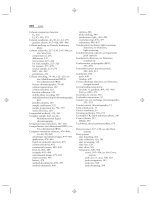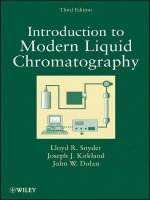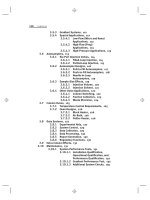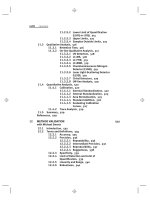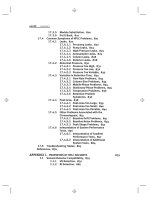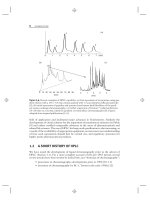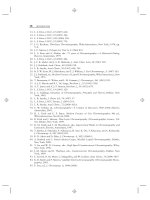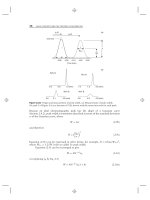Introduction to Modern Liquid Chromatography, Third Edition part 95 pdf
Bạn đang xem bản rút gọn của tài liệu. Xem và tải ngay bản đầy đủ của tài liệu tại đây (159.52 KB, 17 trang )
896 INDEX
Column-comparison function
F
s
, 236
F
s
(-C), 236, 279
Column conditions, 46–50, 61–63, 295
gradient elution, 415–418, 445–446
Column packing; see Particle; Stationary
phase
Column selectivity, 227–238, 345–346; see
also Selectivity
comparison of, 236
differences, 235
interactions, 227–228
for ionic samples, 323–326
for isomers, 277–278
neutral sample, 273–276
NPC, 381–382
parameters, 233
Column switching, 79–80, 122–123; see
also Multidimensional HPLC;
Two-dimensional HPLC
boxcar chromatography, 79–80
column regeneration, 122
column selection, 123
fraction collection, 123
mobile phase recycling, 125
multidimensional liquid chromatography,
618
parallel columns, 123
sample enrichment, 122
sample preparation by, 796–797
waste diversion, 124
Compendial methods, 533, 561
Complex sample, 442; see also
Multidimensional liquid
chromatography
Compound class separation, 365–366
Comprehensive two-dimensional HPLC; see
Two-dimensional HPLC
Computer-simulation software, 476–490;
see also DryLab
advantages and disadvantages, 479–481
application, 478–481
based on molecular structure, 491
column selectivity, 492
commercial sources, 489–490
DryLab, 481–489
examples 492–496
experimental design, 479, 481
expert systems, 492
history, 478
method development, 492–497
method robustness, 480
options, 486
peak tracking, 489
predictions of pK
a
, 491–492
resolution map, 476–477
robustness, 496–497
Condensation nucleation light-scattering
detectors; see Detectors,
light-scattering
Conditional peak capacity; see Equivalent
peak capacity
Conductivity detectors; see Detectors,
conductivity
Conformation, polypeptides (RPC),
593–595
Controlled surface porosity particle,
202–203, 211
Copolymer, 648
graft, 649
random, 649
Corona-discharge detectors; see Detectors,
charged-aerosol
Corresponding separations
isocratic vs. gradient, 409, 413–418
TLC vs. NPC, 373
Corrosion, by citrate, 316
Coulombic interactions, 32
Counter ion, ion-exchange chromatography,
351–354
Countercurrent chromatography, 11
Critical peak-pair, 55
Critical resolution, 55
Crossing isotherms, 750–751
Crownpak CR, chiral stationary phase, 706
Cyano column, 233
HILIC, 397
Cyclobond, chiral stationary phase, 679
Data processor, 127–130; see also Data
systems
Data systems
data bunching, 501
data collection, 129, 501
data processing, 130
data rate, 129
data slices, 501
integration, 500–508
errors, 505–506; see also Error,
sources
peak area vs. area, 508, 529
peak recognition, 503
peak size, 508
peak skimming, 504
INDEX 897
perpendicular drop, 505
retention measurement, 507
LIMS, 128
method-development software, 128
Part 11 compliant, 130
report generation, 130
sampling rate, 129, 154–155, 501–503
signal measurement, 500–516
system control, 129
21 CFR Part 11, 130
Daughter ion, 189
Dead time, 24, 27–28
Dead volume, 26, 28
Deamidation products, polypeptides (RPC),
587
Degassing, 92–96
benefits, 814
Degradation; see Column, degradation;
Sample degradation
Denaturing HPLC, 621–623
Derivatization, 194; see also Sample
preparation, derivatization
Desalting, gel filtration, 641
Detector(s)
back-pressure regulator, 150
bulk property, 151
characteristics, 149–159
charged-aerosol (CAD), 184
chemiluminescent, 174–175
chiral, 175–177, 678
condensation nucleation light-scattering,
(CNLSD), 182–183
conductivity, 174
detection limits, 157–159; see also
Calibration, limits
drift, 153–55
electrochemical, 170–172
error sources, 509
flow cell, 150, 161
fluorescence, 167–170
quenching, 170
FTIR, 191–192
heat exchangers, 150
hyphenated, 152, 185, 191
light-scattering, 180–184
evaporative (ELSD), 181–182
laser (LLSD), 183–184
limits, 157–158; see also Calibration,
limits
linearity (calibration plot); see
Calibration, linearity
linearity(detector), 158–159
mobile-phase modification detectors, 152
MS (mass spectral), 185–191
flow rate considerations, 188
interfaces, 186–188
nitrogen; see Detector(s),
chemiluminescent
NMR, 192–193
noise, 153–55
overload, 727
peak identification; see Peak identification
peak purity, 539
periodic maintenance, 141
preparative separation, 733–734
problems; see Troubleshooting,
symptoms
radioactivity, 172–173
reaction 194–196
refractive index (RI), 177–180
sample-specific, 152
selection, 66
sensitivity, 157
time constant, 153
UV, 160–167
characteristics, 166
history, 148
maintenance, 167
selectivity, 161, 165
wavelength selection, 161
visible; see Detectors, UV
De-wetting; see Stationary phase, dewetting
Diastereomers, 667, 669
Dielectric constant, solvent values, 881
Differential migration, 24
Diffusion coefficient, 44
Diffusive pores, 203
Dinitrobenzoyl (DNB), chiral stationary
phases, 707–708
Diol column, HILIC, 397
Dipole interactions, 32, 228–229
Direct
method, chiral separation, 669,
675–681
Dispersion interactions, 30
Displacement, in NPC, 366–368
Distribution coefficient, SEC, 632
DNA, 620–623,
Documentation; see Validation,
documentation
Dorsey-Foley equation, 53
Drift
baseline, 155
gradient elution, 470, 847–850
Drug product vs. drug substance, 535
898 INDEX
DryLab
®
software, 481–489; see also
Computer-simulation software
gradient optimization, 483–485
isocratic predictions from gradient data,
485–486
method development examples, 492–496
segmented gradients, 485, 488
two-run procedure, 488–489
Dwell time, 424; see also Dwell volume
Dwell volume, 69, 112, 424–425; see also
Gradient, dwell volume
effect on reproducibility, 450–451
measurement, 134
Eddy diffusion, 40
Effective buffer capacity, 312–314
Electrochemical detectors; see Detectors,
electrochemical
Electrostatic interaction, 231–232
Electrostatic repulsion, 227, 228
hydrophilic-interaction chromatography
(ERLIC), 614–616
Eluent, see Mobile phase
Embedded-polar-group (EPG) column,
226–227, 233
Enantiomer separation; see Chiral separation
Enantiomeric detectors; see Detectors, chiral
End-capping, 222
Epimers, 669
Equilibration; see also Column equilibration
gradient elution, 446–449
ion-pair chromatography, 347–349
NPC, 394
Equilibrium, acid-base, 304–309
Equipment; see also specific modules
(pumps, detectors, etc.)
column packing, 241
variation of, 69
Equivalent column, 235–236, 279–282
Equivalent peak capacity, 452
Equivalent separation; see Equivalent
column; Method adjustment
Error sources, 508–512
calibration; see Calibration, errors
Evaporative light-scattering detector; see
Detectors, light-scattering,
evaporative
Excipient peak, 27
Excipients, 535
Experimental design, 286–290, 479, 481
Expert systems, 492
Extra-column effects, 39–40, 42, 131
symptoms, 848, 851
Fast HPLC (fast LC), 63–65
Fast separation, gradient elution, 456–457
Fatty acids, isomer separations, 277
Filters, in-line, 247
Filtration; see specific type, Sample, Mobile
phase, etc.
Final %B, gradient elution, 420–422
Fischer designation, 669
Fittings, 99–104; see also Column, fittings
in-line filter, 103
low-volume mixer, 103
periodic maintenance, 140
Flow rate
optimum, 37
and pressure, 37
verification; see Performance tests, flow
rate
Fluorescence detectors; see Detectors,
fluorescence
Fraction collection, 123, 734–745, 747
Frit, inlet-line, 90
FTIR detector; see Detectors, FTIR
Fused-core
™
particle; see Shell particle
Gas chromatography (GC), 8
Gaussian peak shape, 36, 50, 503
Gel filtration, 631–641; see also
Size-exclusion chromatography
applications, 639–641
columns, 633–636
mobile phases, 636–637
non-ideal behavior, 636, 638
operational considerations, 637–638
Gel permeation chromatography (GPC),
651, 653; see also Size-exclusion
chromatography
history, 7
General elution problem, 75
Generic separation, 406
Ghost peaks; see also Artifact peaks
gradient elution, 470
Global optimum, 57
Glycoproteins, 577–578
GPC; see Gel permeation chromatography
Gradient elution, 75–76, 404–470
applications, 404–407, 423
artifact peaks, 442, 470
band migration, 411–412
baseline drift, 470, 847–850
biochemical separation (RPC), 585–588
INDEX 899
best practices, 418, 449
column conditions, 415–418
complex sample, 442
corresponding separations, 413–418
curved gradients, 407–408
dwell volume, 112, 424–425; see also
Dwell volume
problems, 450–451, 861–864
early elution, 440–441
effect of experimental conditions,
412–434
equations, 430–434
equilibration, 446–449
fast separation, 456–457
final %B, 420–422
generic separation, 406
ghost peaks, 470; see also
Troubleshooting, ghost peaks
gradient conditions, 418–430
gradient delay, 407–408, 422–424
gradient distortion, 860–862
gradient shape, 407–409
gradient volume and gradient
performance, 860–862
high-molecular-weight samples, 406
HILIC, 467–469
IEC, 470
initial %B, 419–420
initial separation, 437–442
irregular samples, 414–415, 428–430
vs. isocratic elution, 404–405, 409–413,
437–440
large molecules, 464–465
late elution, 421, 441
linear gradients (best practices), 407–408
method development, 406, 434–463
method development outline, 435–436
mixer, 112
NPC, 466–467
optimization, 442–446
with DryLab, 483–485
peak capacity, 451–456
peak tailing, 407, 440
polypeptides (RPC), 589–593
pre-mixing mobile phase (best practice),
815
problems, 440–442, 470; see also
Troubleshooting
steep gradients, 860–861
program, 409
range, 407–408, 410, 444–445
regular samples, 414
reproducibility, 449–451
resolution, 434
retention factor k
∗
, 411–412
as sample preparation replacement,
406–407
segmented gradients, 407–408,
425–428, 445
selectivity, 426–428
solvent demixing, 470
starting %B, 419–420
steepness b, 410
step gradient, 407–408
temperature, 443–444
tests; see Performance tests, gradient
theory, 430–434
transfer problems, 424–425, 861–864
when to use, 437–440
Graphitized carbon, 217
particle preparation, 212
Guard column, 247
Guidelines, regulatory, 534, 548
Harmonization, 532
Helium sparging, 170; see also Degassing
Henderson-Hasselbalch equation, 305
Herbicides, fast separation of, 208
Hidden peak; see Peak, missing
High-flow HPLC, 112
High-pressure HPLC, 112; see also U-HPLC
High-pressure liquid chromatography, 8
High-priced liquid chromatography; see
U-HPLC
High-speed liquid chromatography, 8
HILIC, see Hydrophilic interaction
chromatography
Homologs, retention, 82, 260–261
Homopolymer, 648
Horv
´
ath, Csaba, 7
HPLC, 2–7
books, 13–14
characteristics, 1
growth of, 4
history, 6–8
journals, 13
layout, 88–89
method; see Test method
on a chip, 12
precursors, 7
publication growth, 4
sales of, 4
separation modes, 22
900 INDEX
HPLC (contd.)
short courses, 13
vs. SPE, 772
Huber, Josef, 7
Human growth hormone, 426, 590
Human serum albumin (HSA), 694
Humidity, effect on NPC, 392–394
Hummel-Dreyer method, 640
Hybrid particles, 211, 223–224
Hydrodynamic chromatography, 654
Hydrodynamic diameter, 580
in SEC, 633, 634
Hydrofluoric acid cleavage, for ligand
characterization, 222
Hydrogen bonding interactions, 32, 231
Hydrogen-bond acidity, solvent values, 881
Hydrogen-bond basicity, solvent values, 881
Hydrophilic interaction chromatography
(HILIC), 395–401, 613–614
adsorption vs. partition, 396–397
advantages, 395
carbohydrates, 625–626
columns, 397–398
gradient elution, 467–469
method development, 398–400
problems, 401
retention, 396–397
solvent-type selectivity, 399–400
Hydrophobic interaction chromatography
(HIC), 608–612
antichaotropic salt, 610–611
columns, 609–610
nucleic acids, 624
pH, 611
surfactants, 611–612
temperature, 612
Hydrophobic interaction, 31, 230–231
Hydrophobic interferences, 387
Hydrophobic-subtraction model, 229–232
Hydroxyapatite chromatography,
polypeptides, 604–605
Hydroxytestosterone isomers, 276
Hyphenated detectors; see Detectors,
hyphenated
IEC; see Ion-exchange chromatography
Immobilized-metal affinity chromatography,
605–608
Indirect method, chiral separation, 669,
670–675
Infrared detector; see Detectors, FTIR
Initial conditions; see Starting conditions
Injection solvent, 121–122
Injection valves; see Injectors
Injection volume, 120
problems, 70–71, 852
Injectors, 112–118; see also Autosamplers
accuracy, 115
filled-loop, 114, 117, 118
laminar flow, 115
operation, 114
partial-loop, 115, 118
Inlet-line frit, 90
In-line filter, 103
Inorganic particles, 214–217
Installation qualification; see Performance
tests
Insulin, production-scale separation,
642–648
Integrators; see Data systems
Interactions
charge transfer, 33
column, 227–228
dipole, 32
dispersion, 30
hydrogen bonding, 32
hydrophobic, 31
ionic, 32
molecular, 30–35
pi-pi, 33
Internet resources, 13
Interstitial volume, 201, 632
Ion chromatography, 12, 349–350
detection, 174
Ion pairing, buffer, 315–316
Ion suppression, LCMS, 801
Ion trap detectors; see Detectors, MS
Ion-exchange chromatography (IEC),
349–357, 597–607; see
also Nucleic
acids; Carbohydrates
Ion-exchange chromatography
applications, 349–351
columns, 354, 600–601
counter-ion, 351–354
gradient elution, 470
method development, 355
mixed-mode, 355–357
pH effect, 354
retention, 351–352
Ionic interactions, 32
Ionic samples
IEC, 349–356
IPC, 331–349
method development, 327–331
INDEX 901
problems, 329–331
RPC, 319–327
Ionization
effect of %B, 318–319
effect of temperature, 319
sample, 304–309
Ion-moderated partition chromatography,
626–628
Ion-pair chromatography (IPC), 331–349
advantages, 332–334
artifact peaks, 347
buffer effect, 345–346
chaotropes, 343
column type, 345–346
ion-pair reagent, 334–339
method development, 339–347
peak tailing, 349
pH effect, 334–339
problems, 347–349
retention, 334–339
selectivity, 343–346
slow equilibration, 347–349
solvent strength, 344
solvent type, 344
temperature, 345
when to use (best practice), 332
Ion-pair reagent, 332
concentration effect, 336–337
effect on separation, 334–339
type effect, 336–337
Irregular sample, 60–61, 265–267,
428–430
gradient elution, 414–415
Isocratic elution, 20
prediction from gradient run, 437–440
Isomer separations
NPC, 365–366, 382–385
RPC, 276–278
temperature dependence, 276
Isomerism, chiral, 667
Isomers, constitutional, 667
Isotherms
crossing, 750–751
sorption, 737–738
Journals, HPLC, 13
Junk peak, (excipient peak), 27
Kinetic plot, 47–48
Knox equation, 43
Laminar flow, 115
Large-molecule separations, 570–658
Laser light-scattering detectors; see
Detectors, light-scattering
Late elution, gradient elution, 421
LC x LC; see Two-dimensional HPLC
LC-MS
detectors, 185–191
ion suppression, 801
Ligand; see also Stationary phase
alkyl, 226–227
characterization after cleavage with
hydrofluoric acid, 222
cyano, 226
embedded-polar-group column, 226–227
phenyl, 226
type, 225–227
Light-scattering detectors; see Detectors,
light-scattering
Limit of detection, see LOD
Limit of quantification, see LLOQ
Limits; see Calibration, limits
LIMS; see Data systems, LIMS
Linearity, 540
Linearity, detector, 158
Linear-solvent-strength (LSS) model,
409–411
LLOQ, 540; see also Detectors, limits
Local optimum, 57
Localized adsorption, 367–368, 378–380
LOD, 539; see also Detectors, limits
Longitudinal diffusion, 40
LOQ; see LLOQ
Lower limit of quantification; see LLOQ
Low-flow HPLC, 112
Macrocyclic antibiotics, chiral stationary
phases, 699–705
Maintenance,
131–138; see also Repairs
periodic, 812; see also Preventive
maintenance
Map, resolution; see Resolution, map
Martin equation, 82
Martin, Archer (A. J. P.), 7
Mass overload, 71–73, 726, 746
Mass spectral detectors; see Detectors, MS
Mass transfer, mobile phase, 40
Mechanically held polymers, 223
Mercury intrusion, 201
Method (routine); see Test method
Method adjustment, 279–282, 534,
561–564; see also Method
modification
902 INDEX
Method adjustment (contd.)
best practices, 562
buffer, 563
column size, 564
detector wavelength, 564
mobile phase, 563
non-equivalent columns, 282
particle size, 564
pH, 563
temperature, 564
Method change; see Method modification;
Method adjustment
Method development, 65–69, 284–295
column conditions, 61–62
column conditions (gradient), 445–446
computer assisted, 475–497
gradient elution, 434–463
gradient range, 444–445
gradient steepness and k∗, 442
HILIC, 398–400
IEC, 355
initial gradient separation, 437–442
ionic samples, 327–331
IPC, 339–347
neutral samples, 284–295
NPC, 385–392
polypeptides (IEC), 597–603
polypeptides (RPC), 595–597
preparative separation, 745–747
segmented gradients, 445
selectivity (NPC), 389–390
selectivity in gradient elution, 442–444
selectivity, 328–329
starting conditions, 327–328
strategy, 284–286
using gradient elution, 406
Method modification, 534, 561–564; see
also Method adjustment
Method performance
precision; see Precision
robustness; see Robustness
specificity; see Specificity
Method robustness, see Robustness
Method transfer; see also Analytical method
transfer
gradient elution, 450
Methods
bioanalytical, see Bioanalytical methods
category 1, 546
category 2, 547
category 3, 547
category 4, 548
cleaning validation, 547
content uniformity, 546
degradants, 547
dissolution, 547
identification tests, 548
impurities, 547
limit tests, 547
potency, 546
product performance characteristics, 547
quantitative tests, 547
validation, see Validation
Micellar liquid chromatography, 12
Micro HPLC, 112, 170
Micro-column chromatography, 12
Mixer, low-volume, 103
Mixing; see also Mobile phase, mixing
gradient, 112
high-pressure, 109
hybrid systems, 111
low-pressure, 111
on-line, 109–111
Mobile phase, 20; see also Solvent
best practices, 312, 141
degassing, 92
filtration, 89, 91–92
optimum pH, 307–308
recycling, 125
reduced velocity, 44
reservoirs, 90
selectivity; see Selectivity; Solvent
selectivity
solvents for RPC, 254
pre-mixing, 109, 815
velocity, 26
Mobile-phase-additive mode, chiral
separation, 675–677
Modes (HPLC separation modes), 22
Molecular structure, retention predictions
from, 80–83, 491
Molecular weight, biopolymers, 633, 637
Molecular weight, synthetic polymers
average,
653–654
determination, 632–633
distribution, 651–654
Monolayer, adsorbed, 366, 737
Monolith(s), 200, 212–214
advantages and disadvantages, 214
silica based, 213
Monomeric column; see Stationary phase,
monomeric
MS detectors; see Detectors, MS
INDEX 903
Multi-angle light-scattering detectors
(MALS); see Detectors,
light-scattering
Multidimensional liquid chromatography,
616–618; see also Two-dimensional
chromatography
column switching, 618
directly coupled, 617–618
discontinuous, 617
polypeptides, 616–618
Multi-variable optimization, neutral
samples, 286–295
Myoglobin tryptic digest, 592
Nano HPLC, 112
Nanospray ionization sources, polypeptides
(RPC), 595
Naphthalenes, substituted, 289
NARP; see Non-aqueous RPC
Nernst distribution law, 766
New-column test; see Performance tests,
new column test
Nitrogen detector; see Detectors,
chemiluminescent
Nitro-substituted benzenes, 258, 264
NMR detector; see Detectors, NMR
Noise, 153–155; see also Troubleshooting,
symptoms,
Nomograph; see Solvent nomograph
Non-aqueous reversed-phase (NARP), 182,
295–297
Non-localizing solvents, 378–380
Normal-phase chromatography (NPC),
362–401
applications, 362
column selectivity, 381–382
example (Paclitaxel), 390–392
gradient elution, 466–467
isomers, 365–366, 382–385
method development, 385–392
problems, 392–395
reproducibility, 392–394
retention, 363–370
vs. RPC, 363–366
selectivity, 376–385
solvent demixing, 394–395
solvent nomograph, 371–373
solvent strength, 370–373
solvent-strength selectivity, 376
solvent-type selectivity, 376–380
starting conditions, 387–389
tailing peaks, 394–395
temperature, 380–381
Nucleic acids, 574–576, 618–624
anion exchange, 619–620
double stranded, 575–576
hydrophobic interaction
chromatography, 624
RPC, 620–624
sequence failures, 619
single stranded, 574–575
transfer (tRNAs), 619, 620
Oligomers (synthetic), 648
Oligonucleotides, 621; see also Nucleic acids
Oligosaccharides; see Carbohydrates
Operational qualification; see Performance
tests
o-Phthaldialdehyde, 672
Optical isomers separation; see Chiral
separation
Optical rotary dispersion detectors,
175–177
Optimization, 57; see also Method
development; Retention; Selectivity;
Plate Number; Column conditions;
Multi-variable optimization
Orthogonal separation, 68, 236–237,
282–284, 386–387
Ovens; see Column, ovens
Overload, 70–73
column; see Column,
overload
Ovomucoid (OVM), chiral stationary phase,
693
Oxygen, problems with dissolved, 93
Packing methods, column, 240–244
PAH; see Polycyclic aromatic hydrocarbon
Paper chromatography, 2, 7
Parent ion, 189
Particle; see also Column
characterization, 201
configurations; see Particle, type
diameter, 201, 203
electron micrographs, 206, 208
for highly aqueous mobile phases, 224
hybrid, 211
pellicular, 65, 201–202
pore diameter, 201
preparation, 211–212
shell, 65, 202–203
silica sol aggregation, 211
size distribution, 201, 203, 205–207
sol-gel preparation, 211
904 INDEX
Particle; see also Column (contd.)
spherical vs. irregular, 205
spray drying, 211
superficially porous; see Particle, shell
surface area, 201
totally porous, 201
type, 201–203
Peak, 24; see also Band
area measurement, 500–516
area reproducibility; see Performance
tests, peak-area reproducibility
hidden, 68
missing, 236, 282–283
overlooked, 68
shape problems; see Troubleshooting,
symptoms; Peak tailing
size, 508
split, 247
tailing; see Peak tailing
Peak capacity, 76–77, 451–456
optimized, 453–456
polypeptides, 616
two-dimensional HPLC, 461
Peak fronting, 52
Peak height, vs. retention, 57
Peak identification, 516–519; see also
specific detector types
by co-injection, 517
method of standard addition, 517
off-line analysis, 519
by on-line qualitative analysis, 517
by retention time, 516
UV spectra, 518
Peak matching, 77–78, 489
Peak shape, 50–54
Gaussian, 36
Peak tailing, 51, 246–247, 298, 330–331,
854–856
anticipation of, 237
buffer inadequate, 312–314
causes, 52, 237, 854–856
exponential, 52
ion-pair chromatography, 349
overload, 52, 69–73, 739–740
Peak tracking, 77–78, 489
Peak width, 35–54
detector contribution, 158
preparative separation, 738–739
vs. sample weight, 738–739
Pellicular particle, 65, 201–202
Peptides, see Polypeptides
Performance qualification; see Performance
tests
Performance tests, 131–138
flow rate, 135
gradient, 132–135
linearity, 132
proportioning valve test (GPV),
135
step-test, 134
installation qualification (IQ), 132
new column test, 138
operational qualification (OQ), 132
peak area reproducibility, 138
performance qualification (PQ), 132
pressure bleed-down, 136
problems, 856–865; see also
Troubleshooting, performance tests
retention reproducibility, 137
Perfusion particle, 203
Periodic maintenance, 138
Pesticide sample, 773, 775
Pfeiffer’s rule, 680
pH; see also Ionization, sample; Equilibrium,
acid-base; Mobile phase pH
ion-exchange chromatography, 354
ion-pair chromatography, 334–339
meter, use of, 309–310
sensitivity, 329
Pharmaceutical mixture, 492–496
Phase ratio, 26
and surface area, 201
Phase-optimized liquid chromatography,
294
Phenyl columns, 226, 233
Phosphate buffer, 312–317
Phosphopeptides, immobilized-metal affinity
chromatography,
606
Phosphoproteins, immobilized-metal affinity
chromatography, 606
Physicochemical data for particles, 244
pi - pi (π - π) interactions, 33, 228,229
Pirkle-type chiral stationary phase, 707–711
pK
a
amino acids, 571–572
buffer, 311–314
carbohydrates, 628
estimation of, 308–309
predictions from solute structure,
491–492
solute, 307–309, 317–318
Plate height, 37–45
reduced, 44
INDEX 905
Plate number, 35–54; see also Column
efficiency; Peak width
approximate, 246
chiral columns, 671, 681
and experimental conditions, 40
optimization, 61–65
well-packed column, 246
Polysaccharide-based chiral stationary
phases, 682–689
Polar endcapped columns, 233, 237
Polar-bonded-phase columns, 362–363
Polarimeters; see Detectors, chiral
Polarity, solvent (P
), 33–34, 880–881
Polycyclic aromatic hydrocarbons
separation of, 234
shape selectivity, 278
temperature dependence, 273
Polymer (synthetic); see Synthetic polymers
Polymerase chain reaction (PCR), RPC, 621
Polymeric particles, 212
Polymeric stationary phase, 218–219,
221–222, 232–233
Polypeptide-bonded column, HILIC, 397
Polypeptides, 571–574
capillary columns, 595
chromatofocusing, 603–604
columns (IEC), 599–601
columns (RPC). 585
conformation effect, 593–595
ERLIC, 614–616
gradient elution (RPC), 589–593
HILIC applications, 614
hydrophilic interaction chromatography
(HILIC), 613–614
hydrophobic interaction chromatography
(HIC), 608–612
hydroxyapatite chromatography,
604–605
immobilized-metal affinity
chromatography, 605–608
method development (IEC), 597–603
method development (RPC), 595–597
mixed-mode retention (RPC), 593
mobile phases (IEC), 601–603
mobile phases (RPC), 585–588
molecular weight effect, 589–591
multidimensional liquid chromatography,
616–618
post-translational modification, 574
preparative separation, 641–648
primary sequence, 571–572
quaternary structure, 574
retention vs. pH (IEC), 598–599
RPC, 584–597
secondary structure, 573
separation, 584–618
starting conditions (RPC), 596
surfactants (RPC), 588
temperature effects, 588–589, 593–595
tertiary structure, 574
Polyphosphates, ion-exchange
chromatography of, 351–352
Poor retention
gradient elution, 440–441
RPC, 331
Poppe plot, 47–48
Pore diameter, 201
Pore size
columns for biochromatography,
579–581
SEC columns, 635
Pore volume, 632
Porous polymers, 212
Post-translational modification
polypeptide, 574
polypeptide variants (RPC), 587
Precision, 508, 536–538
bioanalytical methods, 550
intermediate, 537
intra-assay, 536
repeatability, 536
reproducibility, 537
ruggedness, 538
and signal-to-noise, 156
Precursor ion, 189
Preparative separation, 112, 726–755; see
also Column, overload
applications, 726
column diameter, 728
column saturation capacity, 737
columns, 730–731
crossing isotherms, 750–751
detectors, 733–734
equipment, 730–736
fraction collection, 734–745, 747
gradient elution, 751–754
initial conditions, 745
isocratic elution, 736–747
isocratic vs. gradient elution, 752
mass overload, 726, 746
method development, 745–747
mobile phase, 743
optimized conditions, 728
peak width, 738–739
906 INDEX
Preparative separation (contd.)
production scale, 754–755
recovery vs. purity, 748
sample injection, 731–733
sample solubility, 742–745
sample solvent, 743–745
scale-up, 728
separation scale, 727–730
severe overload, 748–751
solvent removal, 728–729, 735–736
sorption isotherm, 737–738
temperature, 745
touching-peak separation, 727, 739–748
volume overload, 742
Prep-LC; see Preparative separation
Pressure; see also Solvent, viscosity values
and flow rate, 37
surge, 247–248
test; see Performance tests, pressure
Pressurized fluid extraction (PFE), 795
Pre-validation, 545
Preventive maintenance, 138, 141; see
Maintenance; Repairs
Primary sequence, polypeptide, 571–572
Priming valve, 108
Problems, 297–298 ; see also specific
problems; Troubleshooting
gradient elution, 470
HILIC, 401
ionic samples, 329–331
NPC, 392–395
troubleshooting tables, 865–888
Product ion, 189
Production-scale separation, rh-insulin,
642–648
Protein; see also Polypeptides
aggregation, gel filtration, 640
contact area, 583
folding, gel filtration, 639–640
Regnier rules, 583–584
structure vs. chromatography, 583–584
Proteomics, multidimensional liquid
chromatography, 616–618
Protocol; see Validation, protocol
Pseudocritical chromatography, 654
Pump(s), 104–113
active check valves, 109
check valves, 106
periodic maintenance (best practice), 140
priming valve, 108
purge valve, 108
reciprocating-piston, 104–109
seal replacement, 823–824
seals, problems; see also
Troubleshooting, symptoms
Purge valve, 108
Pyrimidines, 398
QC samples, 543, 549, 552
Quadrupole detectors; see Detectors, MS
Qualification; see Performance tests
Qualitative analysis, 516–519; see also Peak
identification
Quality assurance, 564–565
Quality control, 564–565
QC samples, 543
Quality unit, 564
Quantitative analysis, 516–519; see also
Peak identification; Detectors
Quaternary ammonium salts for ion-pairing,
340–342
Quaternary structure, polypeptide, 574
Quick fix, 809–810, 865–888
Radial-compression column, 239
Radioactivity detectors, 172–173
Range
gradient, 407–408, 444–445
method, 540
Reaction detectors, 194–196
Reciprocity principle of chiral recognition,
707
Reduced parameters, 44
Refractive index detectors; see Detectors,
refractive index
Regnier rules, 583–584
Regular sample, 60–61, 265–267
gradient elution, 414
Relative retention; see Selectivity
Repairs,
143
personnel, 143, 144
record keeping, 143, 144
system configuration record, 143
Reproducibility
column, 68
gradient elution, 449–451
gradient method development, 449–450
NPC, 392–394
routine gradient assays, 450–451
Reservoir, 89–91
frit, 90
periodic maintenance, 138
Resolution map, 271–273
Resolution, 54–57
INDEX 907
critical, 55
equations, 54, 55
gradient elution, 434
map, 271–273
vs. retention, 57–59
selectivity, see Selectivity
size-exclusion chromatography, 636
Restricted diffusion, 203
Retention, 24–35, 256–263
vs. conditions, 28–30
ion-pair chromatography, 334–339
NPC, 363–370
vs. %B, 58
pH effect, 304–309
poor, 297–298, 331, 387
prediction based on structure , 80–83,
491
problems; see Troubleshooting,
symptoms
process, 259–263
recommended range, 265
reproducibility; see Performance tests,
retention reproducibility
RPC, 28–30, 256–257
SEC, 632–633
vs. solvent strength (RPC), 58
temperature dependence, 34, 270
time, measurement of, 24, 507; see also
Data systems, integration
Retention factor, 25–28
Retention factor, desired range, 57
gradient; see Gradient, retention factor k∗
optimizing, 57
small values, 297–298
Retention range, narrowing of, 332–333
Retinol isomers, 383–385
Reversed-phase chromatography (RPC), 20,
253–355; see also specific items
(e.g., Columns; RPC normally
assumed)
advantages, 254
history, 255–256
nucleic acids, 620–624
polypeptides, 584–597
preferred conditions (isocratic), 255
preferred solvents, 254
retention process, 259–263
Reviewer guidance, 534, 543
Reviews, HPLC, 13
RI detectors; see Detectors, refractive index
RI values, solvent, 879–880
Ribonuclease, conformational effects (RPC),
593–595
Ristocetin A, chiral stationary phase, 699
Robustness, 540–542
computer-simulation, 480
lack of, 68
RPC-5 chromatography, 623–624
Rule of one, 820
Rule of2.5, 58–59, 121
Run time, minimizing295
Safety, 819, 883
Sample(s); see also Solute
irregular; see Irregular sample
non-ionic, 254–298
regular; see Regular sample
Sample degradation, 855–856
Sample enrichment, 122
Sample injection, preparative separation,
731–733
Sample peak capacity; see Equivalent peak
capacity
Sample preparation, 66, 757–804
affinity techniques, 800
biochromatography, 797–800
column switching, 796–797
derivatization, 194, 802–804
dialysis, 800
dilute and shoot, 760
drying, 762–763
electrodialysis, 800
filtration, 763–764
ion-exchange, 802
LC-MS samples, 800–802
liquid samples, 764
liquid-liquid
extraction (LLE), 764–771
counter-current distribution, 768
emulsions, 769
extraction efficiency, 766
flowchart, 765
immobilized liquid extraction
(ILE), 770–771
microextraction, 770
problems, 768–769
SDME, 770
solid-supported microextraction
(SLE), 770
solute binding, 769
solvent selection, 767
special approaches, 770–771
theory, 766
membrane techniques, 790
908 INDEX
Sample preparation (contd.)
overview, 758–759
particle-size reduction, 760, 762
precipitation, 802
preliminary processing, 760–764
restricted access media (RAM), 802
solid samples, 791–796; see also
Samples, solid
solid-phase extraction; see Solid-phase
extraction
turbulent-flow, 802
types of samples, 759–760
ultrafiltration (UF), 800
Sample pretreatment; see Sample
preparation
Sample size, 69–74; see also Preparative
separations
problems, 73–74
size effects, 119–121
Saturation capacity, column, 740–742
Scale-up, 728
Secondary equilibria, 78–79
Secondary structure, polypeptide, 573
Segmented gradients, 422–428,
445
Selectivity, 55, 263–284
amine modifiers, 327
buffer concentration, 327
buffer type, 326–327
column, 293–295, 323–325, 345–346
gradient elution, 442–444
ion exchange chromatography, 352–355
ionic samples, 320–327
ion-pair chromatography, 343–346
isomer, 276–278
NPC, 376–385
optimization, 59–61
pH, 320–322
RPC, 263–284, 320–327
shape, 232–235
solvent-strength, 322–323
NPC, 376
and solvent-type, 290–292
and temperature, 290–293
solvent-type, 263–270, 287–290, 323,
344–345
HILIC, 399–400
NPC, 376–380
stationary phase, 293–295, 323–325,
345–346
temperature (NPC), 380–381
temperature (RPC), 270–273
Sensitivity, 158
poor, 68
Separation
conditions, choosing, 67
large molecules, 570–658
modes (HPLC separation modes), 22
orthogonal, 68, 282–284
process, 20–24
Sequence failures, nucleic acids, 619
Service contracts, 143
SFC; see Supercritical fluid chromatography
Shape selectivity, 232–235, 277–278
Shell particles, 202–203, 211
Short courses, HPLC, 13
Signal measurement, 500–516
Signal-to-noise, 155–156
error contribution, 512
improving, 156
and precision, 156
Silanol, 208–209
acidity, 209–210, 231
effect on separation, 330–331
endcapping, 222
ionization, 210
Silica
acidity, 210
advantages (NPC), 362
column, HILIC. 397–398
column, use with organic buffers, 249
comparison with other metal oxides, 215
contaminating metals, 209
dissolution, 248–249
measurement of metal contaminants, 209
purity, 209–210
silanols, 208–211; see also Silanol
sintering, 212
sol aggregation, 211
supports, 203–212
surface composition, 208–211
trace elements in, 209
type-A, 209, 231–232
type-B, 209, 231–232
type-C, 222
Silver-ion complexation, 277
Sintering, 212
Siphon test, 90–91, 814
Size-exclusion
chromatography (SEC),
631–641; see also Gel filtration
advantages and limitations, 638–639
calibration plot, 632–633
retention, 632–633
synthetic polymers, 653
INDEX 909
Slot model of shape selectivity, 278
Soczewinski equation, 369
Sol-gel preparation, 211
Solid samples
microwave-accelerated solvent
extraction, 795–796
microwave-assisted solvent extraction
(MAE), 795–796
pressurized fluid extraction (PFE), 795
pressurized solvent extraction (PSE), 795
shake-flask method, 793
solid samples, supercritical fluid
extraction (SFE), 794–795
sonication, 793
Soxhlet extraction, 791–794
Solid-phase extraction (SPE), 771–790
advantages and disadvantages, 771
apparatus, 777–778
automation, 778
cartridges, 774
class-specific cartridges, 789
coated fibers (SPME), 776
conditioning, 779–780
derivatization in-situ, 774
desalting, 774
devices, 774–776
disks, 775
dispersive SPE, 789–790
elution, 781
enrichment, 773
example, 784–786
vs. HPLC, 772
immunoaffinity extraction, 788–789
interference removal, 772–773
loading, 780
method development, 778–785
micropipette tip, 776
mixed-mode, 781
molecular-imprinted polymers (MIPs),
787–788
multimodal extractions, 785
96-well plate, 776
packings, 781–784
QuEChERs, 789–790
restricted-access media (RAM), 785–787
robots, 778
solvent exchange, 774
steps in use, 779–781
stir-bar sorbent extraction (SBSE), 776
uses, 772–774
washing, 780
Solubility, sample, 742–745
Solute, 23; see also Sample
amphoteric, 309, 311
ionic, 304–357
neutral, 253–298
polarity and retention, 29
Solvation parameter model, 82–83
Solvent; see also Mobile phase
basic (NPC), 372, 379
boiling points, 880
demixing, 375
gradient elution, 470
NPC, 394–395
density values, 882
detector compatibility, 877–880
filtration, 89
localizing, 372, 378–380
mixtures (ternary, quaternary), 287–290
nomograph (NPC), 371–373
nomograph (RPC), 269–270
non-basic (NPC), 372, 379
non-localizing (NPC), 372, 378–380
polarity values (P
), 33–34, 880–881
preferred, 254, 287–288
properties, 877–883
RI values, 879–880
safety, 883
selectivity triangle, 33–34
selectivity values, 880–881
strength, 28–29, 257–259
ion-pair chromatography, 344
NPC, 370–373
parameter ε, 370–373
prediction of, 258
strong, 29
UV absorbance, 877–879
viscosity values, 880
water-saturated, 392–393
weak, 28
Solvent-selectivity triangle, 288
Solvent-strength selectivity; see Selectivity,
solvent-strength
SPE; see Solid-phase extraction (SPE)
Specifications, column, 244–246
Specificity, 539
comparison to known materials, 539
separation from other compounds, 539
Spray drying, 211
Stability; see Stationary phase, stability
Starting %B, gradient elution, 419–420
Starting conditions
gradient elution, 437–438
HILIC, 395–396
910 INDEX
Starting conditions (contd.)
IPC, 340–343
NPC, 387–389
polypeptides (RPC), 596
preparative separation, 745
RPC, 254–255, 327–328
Stationary phase, 217–227
alkyl ligands, 226–227
bidentate silanes, 248
collapse; see Stationary phase, de-wetting
cyano, 226
de-wetting, 224, 237, 298
embedded polar group, 226–227
functionality, 225–227
‘‘horizontal’’ vs. ‘‘vertical’’
polymerization, 219–220
monomeric, 218–219, 232–234
phenyl, 226
polymeric, 218–219, 221–222, 232–234
preparation, 218–225
selectivity; see Column selectivity
stability, 220–222
steric protected, 220–221
synthesis; see Stationary phase,
preparation of
Step-test; see Performance tests, gradient,
step-test
Steric exclusion, 227, 228, 231
Steric interaction, 232–235
Sterically protected stationary phase,
220–221
Storage, column, 249
Strong solvent, 29
Substituted anilines, 364–366
Substituted naphthalenes, 289
Supercritical fluid chromatography, 10
Superficially porous particle, 202–203, 211
Support, 200
Surface area, 201
Surrogate biopolymer, 583
Symptoms, troubleshooting tables, 865–888
Synthetic polymers, 648–658
analysis, 651–653
chemical composition vs. molecular
weight, 656–657
critical conditions, 655
interactive liquid chromatography,
653–655
molecular structure vs. chromatography,
650–651
structures, 648–649
two-dimensional chromatography,
657–658
System controller; see Data systems
System maintenance; see Maintenance
System suitability, 69, 542–543, 813
Tacticity, 649
Tailing factor, 51
Tailing peaks; see also Peak tailing
gradient elution, 440
NPC, 394–395
Tandem MS; see Detectors, MS
Temperature
control requirements, 125; see also
Column, ovens
control problems, 854–855
high, 64–65
ion-pair chromatography, 345
method adjustment, 280–281
and pressure, 38–39
problems, 64–65
and retention, 34
selectivity (NPC), 380–381
sensitivity, 331
Tertiary structure, polypeptide, 574
Test method
assay, 535
bioanalytical, 535, 553
content uniformity, 535
dissolution, 535
document, 544
impurity test, 535
stability-indicating, 535
synonyms, 532
Tetraalkyl-o-silicate, 211
TFA (trifluoroacetic acid)
concentration effects, 848
ion pairing with polypeptides, 587
polypeptides (RPC), 586
troubleshooting
, 817
Thermally-tuned tandem-column, 294
Thin-layer chromatography, 2, 373–376
R
F
values, 373–375
Three-point interaction model, chiral
separation, 678, 679,680
Through-pores, 203
Time-of-flight detector, see Detector(s), MS
Titania particles, 217
TOF detector; see Detectors, MS,
time-of-flight
Touching-peak separation, 727, 739–748
Toxicology standards, 405
INDEX 911
Trace analysis, 73–74, 529
Triazine herbicide sample, 788
Tricarboxymethylethylenediamine (TED),
607
Trifluoroacetic acid; see TFA
Triple-quadrupole detector, see Detectors,
MS
Troubleshooting; see also Troubleshooting
symptoms
adsorption of sample, 818–819
air, removing from pump, 814
baseline drift, 817
best practices, 814–819
blockages, 814
bubbles, 814
carryover, 818–819
case studies, 856–865
cause-and-effect, 865–888
check valves, 815–816
column-size problems, 834
data error sources, 508–512; see also
Error, sources
data systems, see Data systems
divide-and-and conquer strategy,
819–820
fittings, PEEK, 816
flow-rate problems, 834
ghost peaks, 816–817
glassware cleaning, 816–817
gradient noise, 815
gradient transfer problems, 861–864
integration errors, 505–506
leaks, detection and repair, 816
maintenance; see Maintenance
mixing problems, 815
mobile-phase problems, 824–835
module substitution, 820
new-column test, 819–820
performance tests, 811–812, 856–865
flow-rate problems, 864
GPV test failure, 858–859
gradient linearity, 857–861
gradient, 812
gradient test failure, 857–864
IQ, OQ, PQ, 812
other, 812
pressure bleed-down problems, 864
retention-time reproducibility,
864–865
step-test failure, 857–859
prioritizing tests, 820
problem isolation, 819–821
problem prevention, 811–819
problem symptoms; see Troubleshooting,
symptoms
quick fix, 812–813
records, 813–814
retention-time, changes, 836–838
siphon test, 90–91, 814
stationary-phase problems, 835
symptoms; see Troubleshooting
symptoms
system suitability, 813
tables, 865–888
TFA, 817
tips and techniques, 814–819
water purity, 817–818
Troubleshooting symptoms, 821–888; see
also Troubleshooting
artifact peaks, 846–847
baseline drift, 841–844
baseline noise, 844–847
broad peaks, 850
carryover, 839
cyclic baseline, 845
detector, 828–830
double peaks, 850, 852–854
flat-top peaks, 850
frit blockage, 853
ghost peaks, 846–847
gradient baseline, 841-, 846–847
gradient shape problems, 857–864
high-frequency noise, 844
injector problems, 825
late peaks, 839, 845
leaks, 822
autosampler, 825–828
column, 828
detector, 828–830
high-pressure, 825
pre-pump, 822–821
pump,
823–824
low-frequency noise, 844
low-pressure, 822
overload peaks, 850
peak-area problems, 838–841
peak-area ratios changing, 854–855
peak fronting, 849–851
peak shape, 847–856
peak splitting, 850, 852–854
peak tailing, 847–849
pressure problems 830–834
pump seal problems, 823–824
random noise, 844
912 INDEX
Troubleshooting symptoms (contd.)
retention problems, 833–838, 854–855
spikes in baseline, 845
temperature changes, 844
temperature problems, 836
Tswett, Mikhail, 7
Tubing, 96–99
diameters, 98
high-pressure, 97–99
length, 99
low-pressure, 96–97
PEEK, 97
periodic maintenance, 140
stainless steel, 97
21 CFR Part 11,506–507
Two-dimensional HPLC, 76–77, 457–464,
657–658; see also Multidimensional
liquid chromatography
equipment, 461–462
examples, 460
method development, 462–464
mobile phase compatibility, 463–464
orthogonal conditions, 463
peak capacity, 461
Type-A columns, 209, 231–232,
330–331
Type-B columns, 209, 231–232
Type-B silica, for NPC, 363
Type-C columns, 222
U-HPLC (ultra-high-pressure LC), 63–64,
112
ULMO chiral stationary phase, 708, 710
UPLC, 112; see also U-HPLC
Urine separation, 5
UV absorbance, solvent, 877–879
UV detectors; see Detectors, UV
UV-visible detectors; see Detectors, UV
Validation, 69
bioanalytical methods, 548–554
cleaning, 547
documentation, 543–546
overview, 532–534
pharmaceutical methods, 546–548
regulatory guidelines, 533
terms and definitions, 534–542
Valves, switching, 122
van Deemter equation, 43
Vancomycin chiral stationary phases, 699,
702
Viruses, 578–579, 630–631
Viscosity
acetonitrile-water mixtures vs.
temperature, 882
effect on diffusion, 44
effect on pressure, 38–39
methanol-water mixtures vs.
temperature, 882
solvent values, 880
Vitamins, water soluble, 342–343
Waste container, periodic maintenance, 141
Waste diversion, 124
Water sample, 193, 773, 775
Water-saturated solvents, 392–393
Weak solvent, 28
WHELK-O1 chiral stationary phase, 708
Wilke-Chang equation, 44
Zirconia particles, 215–217
Zwitterion; see Solute, amphoteric
